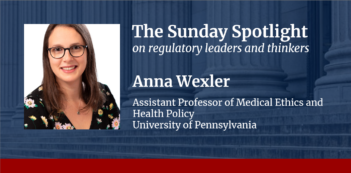
A legal scholar proposes strict advertising limits – but no blanket ban – on e-cigarettes.
Should e-cigarettes be regulated? If so, how should they be regulated? Public health experts are divided on these issues. Some argue for a soft approach, lest regulations impede the potential of e-cigarettes to allow heavy smokers to cease smoking. Other experts call for stricter regulations or banning e-cigarettes altogether, claiming that e-cigarettes pose significant health risks, including the risk of hooking young people on nicotine.
A recent article by Professor Eric N. Lindblom of Georgetown University charts a middle ground: e-cigarette regulation should impose harm-reducing requirements on products and limits on advertising, but e-cigarette sales should still be allowed on a limited basis. According to Lindblom, the U.S. Food and Drug Administration (FDA) possesses the authority to take this approach, which would help smokers cease smoking without “causing any offsetting public health harms.”
Recognizing that e-cigarettes have both upsides and downsides for public health, Lindblom lays out three goals that a desirable regulatory framework should aim to achieve. First, it should “make e-cigarettes even less harmful to users and non-users.” Second, it should promote the use of e-cigarettes as a tool to quit smoking – or at least as a cigarette substitute for those who cannot break their smoking habits. Finally, it should “minimize e-cigarette use among all other persons.”
Lindblom points out that the first goal can be readily met simply by imposing some requirements on e-cigarette manufacturing, such as requiring child-proof packaging, or prohibiting additional, toxic additives in e-cigarettes. The second and third goals, however, are more difficult to meet and may be somewhat at odds with each other. These latter two goals are closely related to how and to whom e-cigarette retailers advertise e-cigarettes. But promoting e-cigarettes as a tool to help smokers quit will likely lead to more non-smokers using e-cigarettes, due to increased advertising and visibility. Lindblom’s suggestion tries to fulfill both of these goals, arguing that e-cigarette advertising should be permitted only via “direct communications to pre-verified current adult smokers” and other pre-verified adults, including former smokers, who use e-cigarettes regularly.
What are the merits of his proposed restrictions? A major benefit, Lindblom stresses, lies in their simplicity. If governments endeavor to regulate each form of e-cigarette advertising individually, the structure, implementation, and enforcement of the regulation will become overly complex. By contrast, combining a ban on general advertising with the permissibility of targeted, direct communication will theoretically result in “the least harm” and “the most good,” Lindblom advocates.
The FDA has seemingly chosen a different path to regulate e-cigarettes, as it recently proposed a rule aiming to classify e-cigarettes as “tobacco products” and regulate them like cigarettes under the Family Smoking Prevention and Tobacco Control Act. For example, under the proposed rule, any manufacturer or importer of e-cigarettes would need to get a permissive order from the FDA to market a “modified risk tobacco product.” However, the FDA’s proposed rule includes no new restrictions specifically related to e-cigarette advertising, such as those urged by Lindblom.
Yet Lindblom argues that his suggested approach can be accommodated under the framework of the FDA’s proposed regulation. He claims that the FDA could “exercise its enforcement discretion to allow existing e-cigarette brands to stay on the market,” if the manufacturers or importers file an application within a certain periods. Lindblom suggests the FDA should announce that it will exercise its discretion and refrain from enforcement as long as manufacturers or importers ensure that e-cigarettes comply with basic harm-reducing requirements and that e-cigarette advertising is conducted only through “direct communications,” including e-mails and text messages, to pre-verified current or former adult smokers.
Lindblom anticipates that his approach would surely face First Amendment challenges, particularly with respect to regulating e-cigarette advertising. However, he concludes that such challenges could be overcome, arguing that e-cigarette advertising under those restrictions would not qualify for First Amendment protections.
Lindblom outlines the constitutionality of his proposed e-cigarette advertising restrictions under the Supreme Court’s test for constitutionally permissible government restrictions of commercial speech. The test, established by the Court in Central Hudson Gas & Electric Corp. v. Public Service Commission of NY, asks whether the speech concerns a lawful activity and is not misleading; whether the government has a substantial interest justifying the restriction; whether the restriction “directly advances” that interest; and whether the restriction is more extensive than needed in order to serve the government interest.
Under this test, Lindblom argues that e-cigarette advertising has the risk of encouraging youths’ purchases and possessions of e-cigarettes that will become illegal after the FDA’s regulation is implemented. Thus, the advertisements, which would relate to an illegal activity, would not receive First Amendment protections. Further, Lindblom claims that e-cigarette advertising is indeed misleading as in general, it tends to be “more likely to deceive the public than inform it.”
To satisfy the second and third requirements of the test, according to Lindblom, the FDA could advocate that it has substantial interests in “the protection of the public health,” as well as in the prevention of “fraudulent claims and consumer deception.” He asserts that the proposed restrictions promote these substantial government interests “directly,” for product advertising is closely related to the demand for the product.
Lindblom interprets the final requirement as asking whether the suggested restrictions would “unduly impinge” a seller’s ability to communicate with specific qualified consumers. He argues that the restrictions would not, because e-cigarette manufacturers could easily reach their legitimate customers directly or indirectly.
Lindblom illustrates the merits of his proposed middle-ground approach, and demonstrates the likelihood that it would clear any First Amendment hurdles. Although he acknowledges that his analysis is only based on the research and data available now, Lindblom believes that his approach will deliver many benefits and few costs for society.



